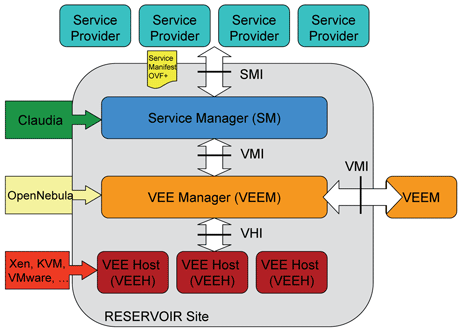The RESERVOIR project is developing breakthrough system and service technologies that will serve as an infrastructure as a service (IaaS) using Cloud computing. The project is taking virtualization forward to the next level in order to allow efficient migration of resources across geographies and administrative domains, maximizing resource exploitation, and minimizing their utilization costs.
Resources and Services Virtualization without Barriers (RESERVOIR) is a European Framework Programme 7 (FP7) funded project that will enable massive scale deployment and management of complex IT services across different administrative domains, IT platforms and geographies. Figure 1 shows a high-level description of RESERVOIR architecture. A detailed description is available on the project website. The project consortium is coordinated by IBM Haifa Research Lab, and includes a good balance of industry and academia.

Figure 1: RESERVOIR architecture.
The RESERVOIR project aims to support the emergence of Service-Oriented Computing (SOC) as a new computing paradigm. In this paradigm, services are software components exposed through network-accessible, platform and language independent interfaces, which enable the composition of complex distributed applications out of loosely coupled components. RESERVOIR project is extending, combining and integrating three core technologies: Virtualization, Grid computing and Business Service Management (BSM). This approach is taken in order to realise the vision of ubiquitous utility computing by harnessing the synergy between the complementary strengths of these technologies.
Provisioning Services as Utilities
The vision of RESERVOIR is to enable the delivery of services on an on-demand basis, at competitive costs, and without requiring a large capital investment in infrastructure. This vision is inspired by the delivery of utilities in the physical world. A typical scenario in the physical world is the ability of an electrical grid in one country to dynamically provide more electric power to a grid in a neighbouring country to meet a spike in demand. It is evident that provisioning on-demand services from disparate service domains is far more complex than the provisioning of a utility in physical world. We are addressing these issues to overcome the barriers to delivering services as utilities.
Advanced End-to-End Support for Service-Oriented Computing
Service-Oriented Computing (SOC) is a paradigm shift in the way software applications are designed and implemented to support business processes and users. SOC is built on the Service Oriented Architecture (SOA) that has the following characteristics:
- Services are reusable
- Services are autonomous, loosely coupled, and platform independent
- Services need to conform to the requirements of a service contract
- Services can be combined to form larger, multi-tier solutions
- Services can be described, published and discovered.
While SOA provides the general architecture to enable SOC, it does not address the fundamental issues required for an actual deployable solution, such as end-to-end security, service deployment, management and orchestration, service billing, and interpretation and monitoring of Service Level Agreement (SLA) conditions. RESERVOIR, as an infrastructure project, is developing the technologies required to address these gaps, making the SOC paradigm a reality in the European economy.
Service and Resource Migration without boundaries
The logical separation of a computing process and its physical hosting environment enables the migration of the process from one physical environment to another without affecting the process itself. Today, this separation is achieved either (1) by limiting the knowledge that the computing process has about its execution environment, or (2) by imposing hard configuration constraints to the infrastructure.
The first approach, commonly used in today’s scientific applications, is restricted to self-contained independent processes that can be easily checkpointed and restarted elsewhere, for example processes that analyse large amounts of data but rarely interact with other processes or users. This restriction renders this approach inappropriate for the type of commercial services that RESERVOIR aims to support.
In the second approach, widely used in today’s commercial server virtualization offerings, the configuration of all the physical resources in the infrastructure has to be identical. For example, the commercial VMotion product from VMware only supports migration when the source and destination hypervisors are on the same subnet and have shared storage. Clearly, these configuration limitations make this approach inapplicable to large geographically distributed infrastructures that span several administrative domains.
RESERVOIR is removing these limitations/boundaries by taking virtualization forward to the next level enabling the migration of resources across geographies and administrative domains, maximizing resource exploitation, and minimizing their utilization costs.
Federated Heterogeneous Infrastructure and Management
Commercial virtualization systems typically offer non-standard management interfaces that are limited to their proprietary technologies and environments. RESERVOIR, in contrast, is developing an abstraction layer to facilitate the development of a set of high level management components that are not tied to any specific environment. To demonstrate the applicability of this generic management layer, we are using two different virtualization technologies: Virtual Machines (VMs) and Virtual Java Service Containers (VJSCs) by Sun. RESERVOIR is collaborating with standardization bodies (DMTF, LIBVIRT) to create standard interfaces that will enable interaction between distributed sites or Grid environments, allowing the federation of infrastructures.
Links:
http://reservoir-fp7.eu
Guide to RESERVOIR Framework:
http://www.reservoir-fp7.eu/uploads/Training/RESERVOIR_Framework_V1_022010.pdf
http://www.reservoir-fp7.eu/uploads/ Training/RESERVOIR_Framework_Guide_Website.pdf
CETIC: http://www.cetic.be
Please contact:
Syed Naqvi, CETIC, Belgium
Tel: +32 71 49 07 41
E-mail:
Philippe Massonet, CETIC, Belgium
Tel: +32 71 49 07 44
E-mail:










